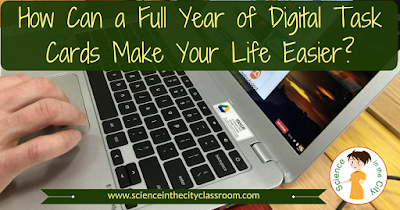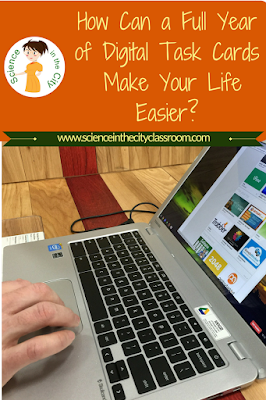Mar 18, 2017

How Can Digital Task Cards Make Your Life Easier?
My son was up sick last night. I'm exhausted. I feel like I might be coming down with something. and my other son has an art show tonight that I really need to attend -- that's after I make dinner and do homework.
I really want to assess where my students are with the topics we have been learning, but I just can't face the idea of coming up with questions, making up a quiz, game or other activity, and then bringing that stack of papers home to grade! I never want to feel like I'm cutting corners with my teaching. but sometimes I need a break. My principal is big on data driven instruction. I do see the value in it, but where am I supposed to get all this data? And how do I have time to analyze it?I need something ready to go, and effective. I have an idea what I want to do tomorrow, but the idea of making a warm up, a closure activity, collecting data and assessing so frequently is too much!
I believe in doing warm ups and tickets out (freebie) and I do them almost every day but I'll be the first to admit that making up questions, and grading them day after day can be tiring. Its an additional piece to your lesson planning on a regular basis. I understand! However, a set of 180 science prompts, 8 general formative assessment prompts, and some blank templates could really take that pressure off! You have a bank of questions and ready made prompts to use.
You may have already seen me writing about ways to use task cards in the classroom, my Human Body Systems Task Cards, the options you have with the full year formative assessment bundle, how to save time grading with google forms and using digital interactive notebooks in general. As you can tell, this is a topic that I feel strongly about. We are in a time period when digital resources really have the potential to make things easier on us, and to make us more effective teachers. Digital task cards can be used so many ways that they really do provide and answer to this.
If you teach biology, this full year bundle covers all that topics that you are likely to teach. The task cards are available in three format (Google Forms, Google slides, and PDF). That means you have options.
If you are looking for a warm up or closure, with data collection, and you have technology you can use the Google Form, and have the data immediately collected and tabulated for you. You can even get graphs of how many students chose which answer if its multiple choice.
If you only have some technology (not 1:1), make it a station.
Maybe you have a short activity, or some notes, but you want to really see how well students understand, use just one task card for a ticket out.
If you are looking for a full-period activity you can use the digital or print versions of the task cards, choose the ones that relate to topics you have already taught, and set up stations. Since each task card has a couple of questions on one topic, it is easy to quickly pick a topic, or a few topics, and get a picture of how your students are doing.
Your students can fill out their answers quickly on one sheet of paper so you have less paper to cart home.
This is a tool that you can use all year long, on any topic. Think of it as a test bank, with ready to go questions and diagrams organized by topic and available as a printable or digital format. It makes it very simple to build in pre-assessments, closure activities and to collect data on a regular basis as you go through the unit.
The next time that you are dragging, and don't feel like making lesson plans, use it as a day to collect some data. Set up stations where students do task cards on recent topics, either digitally (less grading for you!) or on paper and see what they know. Or do a short activity with a ticket out. But know that you have a whole bank of questions to choose from.
Feb 24, 2017

6 Interesting and Simple Tips For Using Photos in Class
Why would you want to use photos in class? And How?
You want to do an activity with your students, but you just don't have the materials to do a great hands-on lab that you imagined. Then you realize that you could do it as a demo, but it will be hard for all the students to see what you are trying to show. And what about students who are absent?
Or maybe you wish you could show your students something under the microscope but don't have a projecting microscope. Perhaps you want to show them other areas of the world, but can't take them there. Sometimes a picture really is worth a 1000 words. A picture is something students will remember and have stuck in their heads.
Where to find photos
As teachers, we should ideally model proper behavior with regard to copyrights and use of photos. There are several sites such as pixabay.com, creative commons search, and other that can be used in class. I was not aware of photosforclass.com and I found this photo that would be great teaching the parts of a flower, or even provoking discussion prior to doing a lab. I loved that when I downloaded this photo, it already came with the credit and citation on it. As far as science, most government sites (think about NASA, USDA, USEPA, etc) are Public Domain because they are government works. You can check those out here
What do with them once you've got them
I could see using photos to help explain a concept, provoke interest, or even for a student who had missed class. They are also great discussion starters to practice skills such as inferencing and to bring concepts back to real life, so that they don't only exist in textbooks or diagrams. We get so used to seeing diagrams, that it can be useful to see real photographs.I was not familiar with BigHugeLabs and I think this could be a lot of fun. Their slogan is "Helping you do cool stuff with your digital photos since 2005. :-)" There are lot of way you could do fun projects with students on here!
It could be useful to make fun, attention-getting posters or bulletin boards, but students could also use this for an assignment. They could use this to make, for example, trading cards for a particular kingdom, or even types of rocks (igneous, sedimentary, metamorphic) using photos they found. Students could also make trading cards or movie posters for famous scientists, for example. This would be a great way to get students working with digital photos as a project.
Using Photos to Reach Outside of the Classroom
The ideas to use instagram in your classroom on a blog could also be used in a classroom blog, website, or newsletter and would be great ideas and great uses for classroom pictures. My son's class uses Bloomz to communicate with parents, and the teacher sometimes takes photos and shares them through Bloomz. It is fun to see what is going on at school, and to have the prompts to talk to him about the class activities. Although this post is labelled for instagram, it certainly wouldn't have to be.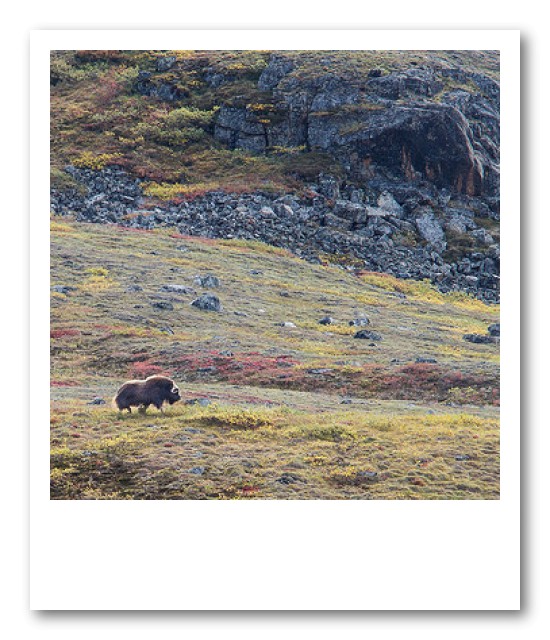 Another fun site is http://photofunia.com/ but I'm not sure the application yet. I used pixlr.com (I think) to create this "Polaroid" and "Postage Stamp" of a faraway place. Students could then write about the geology/weather/climate/wildlife in that place.
Another fun site is http://photofunia.com/ but I'm not sure the application yet. I used pixlr.com (I think) to create this "Polaroid" and "Postage Stamp" of a faraway place. Students could then write about the geology/weather/climate/wildlife in that place.I could see looking at changes in the land use and even the landforms if good historical photos were available, but I had trouble finding a good source.
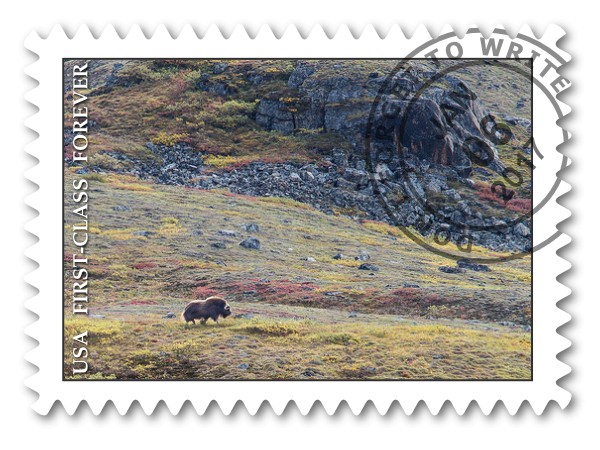 |
photo credit: Ted LaBar Musk Ox via photopin (license) |
A few other related ideas
I have given my students in AP Environmental Science a mapping project where they have to build up a map and add environmental events and photographs. This is working well so far. Here is an example. This could be expanded to include more photographs.Years ago I did a project on weathering and erosion using this website, which has photographs and data on a real rock wall, built of all different types of rock, from all over the US (or the world?)
Lastly, I really liked the "Dear Photograph" project. The concept behind this project is to "Take a picture of a picture from the past in the present." See an example here. This seems to be done mostly in terms of nostalgia and relationships, which might lend itself better to history or English. I am still pondering where this could be applied.
I'd love to hear how you use photographs in your classroom, or what you do if you are trying to capture and experience for students without hands on materials.
Jan 21, 2017

5 Ways to Engage and Assess Using Task Cards
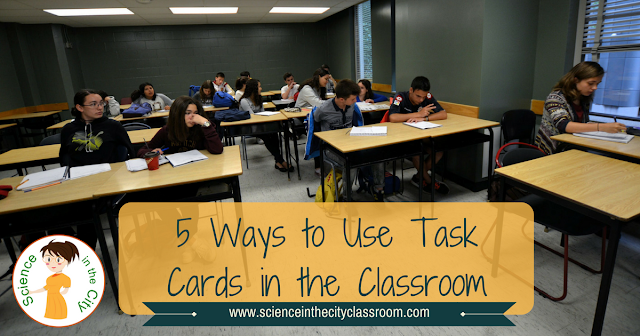
5 Ways to Use Task Cards in the Classroom
I looked out at my class, trying to get their attention as I stood at the board. It seemed, even to me, like the class period would never end. I was tired to trying to remind, redirect, and 'perform' to hold their attention.My class needed a change so that students were active and helping each other learn. I started researching task cards, and they quickly became a necessary part of my classroom. The focus changed so that the students were active, eager to participate, moving around the room, and even doing some self-reflection.
If you've research task cards before, you may see that many of the resources available are geared more towards elementary students, or to subject areas other than science. I want to share with you some great resources for more information on task cards, and the 5 ways that I find them most useful in my classroom. It really is possible for your students to be more engaged and accountable for their learning.
Tweet: Task cards can be a valuable tool to assess knowledge and keep students engaged in creative and differentiated ways.
Subscribe to:
Posts
(
Atom
)







